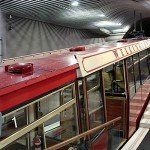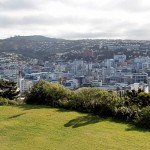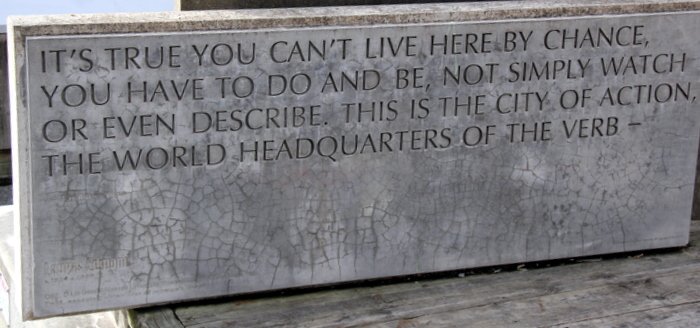Sunday: Rotorua to Wellington
Sunday was road trip day, as we made our way south from Rotorua, past Lake Taupo and into the southern wine country before arriving into Wellington, the capital of New Zealand.
Our first stop was to Huka Falls, a huge rushing stream of the Waikato River as it makes its way downstream. Huka Falls is located just a few kilometers from Taupo and though we had quite a bit of fog this morning in the early part of the drive, the sound of this place is deafening. Over 200,000 liters of water pass through this area every second! The falls are not that tall, only a few meters or so, but the amount of pressure built up behind the rushing water is immense as the channel that the water travels on is reduced in sized by pressurized rock formed from geothermal activity. As the channel of water from the river gets narrower, it gets faster and with a higher amount of pressure and speed as there is really no where else for it to go. Once it reaches the falls it plunges down with such force that the water remains a foamy white color for a significant distance downstream. So much water flows through with such intensity that fish and eels cannot migrate upstream past the falls, leaving several nearby bodies of water without some species of fish!
From here, we drove along the waterfront edge of Lake Taupo as the fog began to lift. The views were great as we continued south onto SH1 and began to make our way towards the capital.
 Along the way, we ended up passing by two national parks with huge mountain peaks covered in snow from the previous set of storms. So much snow fell that we found ourselves driving through several stretches of road with snow on the shoulders and it the highest summit we drove through (800m or 2400 feet) there was between 3-6 inches on the sides of the road, with many weekend travelers stopping to get out of their cars and toss a few snowballs. The roadway was completely clear and safe, so we just enjoyed the scene outside as we continued south along our route. Thankfully our route was opened all the way through to Wellington, whereas just a few days ago, several stretches were closed as they couldn’t keep up with snow removal and de-icing projects during the big dump.
Along the way, we ended up passing by two national parks with huge mountain peaks covered in snow from the previous set of storms. So much snow fell that we found ourselves driving through several stretches of road with snow on the shoulders and it the highest summit we drove through (800m or 2400 feet) there was between 3-6 inches on the sides of the road, with many weekend travelers stopping to get out of their cars and toss a few snowballs. The roadway was completely clear and safe, so we just enjoyed the scene outside as we continued south along our route. Thankfully our route was opened all the way through to Wellington, whereas just a few days ago, several stretches were closed as they couldn’t keep up with snow removal and de-icing projects during the big dump.
We made good time driving south, so we made a side trip along the great wine route (SH2), picking up the highway outside of Palmerston North and taking it south into Wellington (a bit more scenic and lots of wineries in the region). As we arrived into Marnieborough, we made a stop at the local wine center and Natalie tried a few selections from a local winery, Nga Waka, which focused primarily on whites and a couple reds. The guy behind the counter pouring had traveled to the states a number of times, so we had a good political discussion with him about the the impacts of world policy and the political system in the US. It was a nice stop and we headed back into the car for the final leg of our trip.
During this time, Natalie had her first turn behind the wheel, and she did a fine job, given a fairly significant number of two lane, winding, twisting passes as we made our way through.
 We arrived into Wellington just shy of 4:30pm, and got to our hotel where we dropped our bags, got checked into our 19th floor room, and then took the rental car to the station for drop off. Wellington is such an easy city to navigate, everything is close by and for the most part accessible by bus or on foot, that getting rid of the car avoided costly parking in the city center.
We arrived into Wellington just shy of 4:30pm, and got to our hotel where we dropped our bags, got checked into our 19th floor room, and then took the rental car to the station for drop off. Wellington is such an easy city to navigate, everything is close by and for the most part accessible by bus or on foot, that getting rid of the car avoided costly parking in the city center.
A quiet evening gave us a chance to catch up on the basics (shopping, laundry, etc.) and got us prepped for our next two days in the city.
Monday: Te Papa
 Monday was museum day as we traveled to Te Papa (Our Place), the National Museum of New Zealand. Extremely modern and dedicated by none other than Queen Victoria, this six level fortress houses thousands of pieces of art, along with dozens of interactive exhibits covering a wide range of topics including natural history, native peoples, science, popular culture (20th Century Aotearoa), and animals, plants, fish, and just to top it off, an enormous monster squid.
Monday was museum day as we traveled to Te Papa (Our Place), the National Museum of New Zealand. Extremely modern and dedicated by none other than Queen Victoria, this six level fortress houses thousands of pieces of art, along with dozens of interactive exhibits covering a wide range of topics including natural history, native peoples, science, popular culture (20th Century Aotearoa), and animals, plants, fish, and just to top it off, an enormous monster squid.
We started our day from the top, to avoid a crush of foot traffic on the bottom floors, and worked our way down throughout the day. The 6th floor included an exhibit on pottery made by a renowned New Zealand artist. Though this might sound a bit dry, this guy spent years learning from master craftsmen in the UK and spent several years in Africa perfecting his techniques. The results were impressive.
The 5th floor was a non-stop art-fest as we must have worked through the information and pieces covering nearly 250 years of New Zealand history. From oil on canvas to watercolors to sculpture to wood carving to printing plates and modern design, it was a lot to take in, but for the most part very enjoyable.
 It was time for a mental break, so we headed outside to the waterfront to enjoy a picnic lunch and once complete, headed back inside for the reminder of the museum. The 4th floor covered people and popular culture, from the Maori and Moriori to 20th Century New Zealand culture and an engaging exhibit called “Passports” about the stories of immigrants to New Zealand. All were very well put together by the Museum and again had not only a great interactive element, but also allowed all ages to appreciate and enjoy, young and old. In fact, on every level of the museum, there is an “Interaction Area” for kids to learn with their parents, many of which looked like so much fun, that Darin could have easily spent a few hours there…
It was time for a mental break, so we headed outside to the waterfront to enjoy a picnic lunch and once complete, headed back inside for the reminder of the museum. The 4th floor covered people and popular culture, from the Maori and Moriori to 20th Century New Zealand culture and an engaging exhibit called “Passports” about the stories of immigrants to New Zealand. All were very well put together by the Museum and again had not only a great interactive element, but also allowed all ages to appreciate and enjoy, young and old. In fact, on every level of the museum, there is an “Interaction Area” for kids to learn with their parents, many of which looked like so much fun, that Darin could have easily spent a few hours there…
Down to three and to Earth, Blood, and Fire, an exhibit on the land of New Zealand and how it development over time and the influx of plant and animal species to the country have changed and made it what it is today. Included here were a volcano and earthquake exhibit, along with a digital catalog of a number of species of plants and animals that are now extinct and/or introduced to the country.
 The final level, two (level one is just an entry area and gift shop), focused on animals, on land and in the water, where we could see everything from blue whale skeletons to possums, birds, and fish, and that giant squid that was mentioned earlier. Again, the exhibits captured our attention and though our feet could certainly have used a rest, it made for a great day.
The final level, two (level one is just an entry area and gift shop), focused on animals, on land and in the water, where we could see everything from blue whale skeletons to possums, birds, and fish, and that giant squid that was mentioned earlier. Again, the exhibits captured our attention and though our feet could certainly have used a rest, it made for a great day.
Next thing we know, we’re finished up with the museum and it’s already 5pm! It was a great day, but time to head back to our hotel for dinner, to give our feet a rest, and to call it a day.
Tuesday: Cable Car, Botanic Garden, Parliament, and Mount Victoria
 Tuesday morning, the weather continued to look good from our window, so we headed out around 8:30am to board the Wellington Cable Car. The cable car system is smaller than that in San Francisco, offering just 4 stops and two cars that simultaneously go up and down (one in each direction) on a single track with a small dual track section at the middle where the cars can pass one another. The good news is that they run once every 10 minutes allowing for a quick trip up the hills to the lookout, with a beautiful view of Wellington and places you right at the entrance for the city’s Botanic Garden.
Tuesday morning, the weather continued to look good from our window, so we headed out around 8:30am to board the Wellington Cable Car. The cable car system is smaller than that in San Francisco, offering just 4 stops and two cars that simultaneously go up and down (one in each direction) on a single track with a small dual track section at the middle where the cars can pass one another. The good news is that they run once every 10 minutes allowing for a quick trip up the hills to the lookout, with a beautiful view of Wellington and places you right at the entrance for the city’s Botanic Garden.
Established in the late 19th century, the Botanic garden is about 25 hectares in size (about 10 acres in total, if we got the math right) and includes a huge number of plants and gardens, all of which have been nicely manicured and display a wide variety of flowering plants, trees, and paths winding their way down the hills and back towards the city center.
 Next to the Lady Norwood Rose Garden, there was a large greenhouse with a huge number of plants, all protected from the chilly winter temperatures outside, and providing us with a nice spot to warm up in. There were easily a hundred plus different varieties of plants in a kaleidoscope of changing colors. As we worked our way through, we headed back out and onto the easily marked path to guide us through the rest of the garden and back into the city.
Next to the Lady Norwood Rose Garden, there was a large greenhouse with a huge number of plants, all protected from the chilly winter temperatures outside, and providing us with a nice spot to warm up in. There were easily a hundred plus different varieties of plants in a kaleidoscope of changing colors. As we worked our way through, we headed back out and onto the easily marked path to guide us through the rest of the garden and back into the city.
As we reached the edge of the park, we took a short walk through an early cemetery with a number of deceased from colonial times in Wellington. Though most of the graves were over 140 years old, the local parks staff continue to keep the grounds clean and respectful of the deceased.
 From here, we had completed our walk back into the city and had arrived at our next stop of the day — the Parliament buildings for the New Zealand government. Here, the working of the Prime Minister and the House of Representatives (122 of them) handle all of the law making and execution of the country. Here, we were able to take a tour of Parliament, “the Beehive” or the Executive wing, and the Parliament Library. Though no cameras were allowed inside for safety reasons, we got a chance to see the main parliament chamber and walk on the floor as MPs (members of parliament) are out of session. We also got to go into one of the committee rooms (Maori Affairs) and better understand the process of how measures and bills become law in New Zealand. Quickly, our one hour tour wrapped up, and we headed back out onto the waterfront to make our way towards Mt. Victoria.
From here, we had completed our walk back into the city and had arrived at our next stop of the day — the Parliament buildings for the New Zealand government. Here, the working of the Prime Minister and the House of Representatives (122 of them) handle all of the law making and execution of the country. Here, we were able to take a tour of Parliament, “the Beehive” or the Executive wing, and the Parliament Library. Though no cameras were allowed inside for safety reasons, we got a chance to see the main parliament chamber and walk on the floor as MPs (members of parliament) are out of session. We also got to go into one of the committee rooms (Maori Affairs) and better understand the process of how measures and bills become law in New Zealand. Quickly, our one hour tour wrapped up, and we headed back out onto the waterfront to make our way towards Mt. Victoria.
 Mt. Victoria is the highest point in the Wellington area at a height of 196m, or just under 600 feet. A walk up to this height provides sweeping views of the city, and a huge workout for your legs in the process, as though the height is not substantial, the incline is severe. We made our way up the hill using one path to get up the hill, and once on the upper face of the hill, worked our way west and along the ridge-line until exiting at another point. The weather at this point was beautiful with sunshine and clouds and temperatures just shy of 60, with very little wind.
Mt. Victoria is the highest point in the Wellington area at a height of 196m, or just under 600 feet. A walk up to this height provides sweeping views of the city, and a huge workout for your legs in the process, as though the height is not substantial, the incline is severe. We made our way up the hill using one path to get up the hill, and once on the upper face of the hill, worked our way west and along the ridge-line until exiting at another point. The weather at this point was beautiful with sunshine and clouds and temperatures just shy of 60, with very little wind.
It was a great set of days in the nation’s capital. Tomorrow, we head out via the Interislander Ferry across the Cook Strait and onto the South Island, where are next road trip begins.



Leave a reply